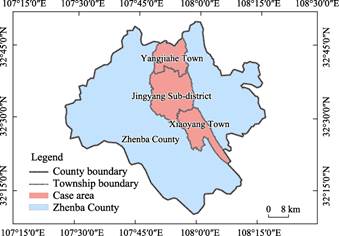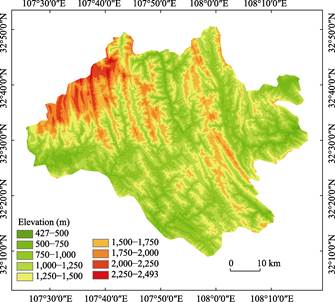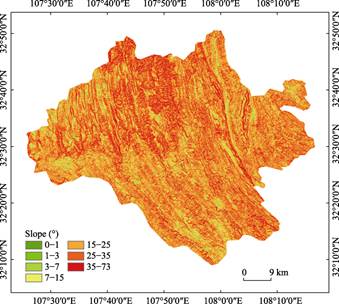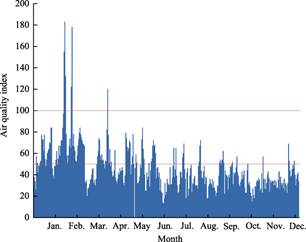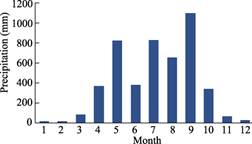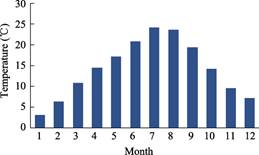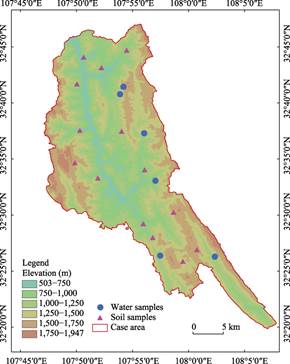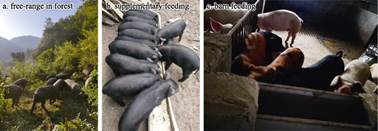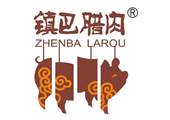Zhenba Bacon From the Northern Subtropical Mountains
Abstract
Zhenba County is located in the southern part of Shaanxi Province, in the hinterland of Daba Mountains, and belongs to the border area of north and south China. The forest coverage rate in Zhenba County reaches 70.5%, with a mild climate and abundant rainfall, which has earned it the reputation of being the “Qinba Oxygen Bar, Botanical Treasure Trove”. Zhenba County is a typical mountainous agricultural planting area with minimal industrial pollution. It is also home to an extremely rich variety of flora and fauna. This unique ecological environment provides an excellent breeding ground for the raw material of bacon—pigs. As a result, the bacon produced in Zhenba is more competitive in terms of meat quality, and flavor. The dataset includes: (1) boundary data of the case area; (2) physical geographical factors (climate, soil, water and vegetation index); (3) heavy metal residues of crops and wild plants used in pig breeding, and classification and efficacy of wild plants in pig breeding; (4) quality and nutrition data of Zhenba bacon; (5) socioeconomic and management data, including population, GDP and management standards, etc. The dataset is archived in .shp, .tif, .xlsx, and .jpg formats, and consists of 59 data files with data size of 118 MB (Compressed into one file with 56.3 MB).
Introduction
Zhenba County is located in the southern part of Shaanxi Province, in the southeastern corner of Hanzhong City. Situated at the southern foot of the Qinling Mountains and the eastern section of the Micang Mountain, Zhenba County is characterized by high mountains, dense forests, and numerous secluded valleys. As a typical mountainous agricultural county, Zhenba County has a long history in livestock and poultry breeding. Among these, pig breeding is one of the leading industries in the county[1]. Given that raw meat is prone to spoilage and difficult to store, local farmers commonly preserve raw pork by salting, air-drying, or smoking it to make bacon. Owing to the inconvenient transportation in the mountainous areas, residents typically rely on bacon as their primary source of meat throughout the year. Zhenba bacon thus has a history spanning thousands of years. Through the combined effects of natural temperature, humidity, and microbial communities, the raw pork is dehydrated and air-dried, resulting in a unique flavor and taste. Benefiting from the high-quality local raw pork, the distinctive natural environment and climate, as well as the elaborate production and preservation techniques of bacon, in December 2010, the former General Administration of Quality Supervision, Inspection and Quarantine approved the implementation of geographical indication product protection for “Zhenba Bacon”.
The “GIES case dataset on Zhenba bacon from the Northern Subtropical Mountains” analyzed the physiographic and climatic conditions, water and soil conditions, pig breeding, bacon processing, and management status of the case area, aiming to provide scientific and technological support for the sustainable development of the Zhenba bacon.
Metadata of the Dataset
The metadata information of the “GIES case dataset on Zhenba bacon from the northern subtropical mountains”[2] is summarized in Table 1.
Table 1 Metadata summary of the GIES case dataset on Zhenba bacon from the northern subtropical mountains
| Items | Description | ||
|---|---|---|---|
| Dataset full name | GIES case dataset on Zhenba bacon from the northern subtropical mountains | ||
| Dataset short name | ZhenbaBaconCase20 | ||
| Authors | Liu, R., Research Center for Eco-Environmental Sciences, Chinese Academy of Sciences, ruiliu@rcees.ac.cn Yu, S. J., Research Center for Eco-Environmental Sciences, Chinese Academy of Sciences, sjyu@rcees.ac.cn Zhu, L. X., Administration for Market Regulation of Zhenba County, Shaanxi Province, ZLX080923@163.com Chen, Y. H., Zhenba County Industrial Park Management Committee of Shaanxi Province Li, C. Y., Food and Drug Supervision and Inspection Center of Hanzhong City, Shaanxi Province Wu, G. F., Shaanxi Zhenhongshule Food Technology Development Co., Ltd. Ma, X. W., Agriculture and Rural Bureau of Zhenba County, Shaanxi Province Li, Y. M., Northwest A&F University Yao, X. K., Shaanxi Normal University, 13379467960@163.com Wang, X. B., Administration for Market Regulation of Zhenba County, Shaanxi Province Lu, H. Z., Shaanxi University of Science and Technology, lhz780823@snut.edu.cn Wang, C. W., Research Center for Eco-Environmental Sciences, Chinese Academy of Sciences, wangchunwan2022@163.com Ran, W., Research Center for Eco-Environmental Sciences, Chinese Academy of Sciences, weiran_st@rcees.ac.cn Jiang, Z. C., Institute of Geographic Sciences and Natural Resources Research, Chinese Academy of Sciences, jiangzhaocai@igsnrr.ac.cn | ||
| Geographical region | Jinyang Sub-district, Xiaoyang Town, and Yangjiahe Town, Zhenba County, Shaanxi Province | ||
| Year | 2023 | ||
| Data format | .shp, .xlsx, .tif, .jpg, etc. | ||
| Data size | 56.3 MB(after compression) | ||
| Data files | Geographic location data of the case area, geographical environment data, heavy metal residue of crops for pig farming and classification and effects of wild plants, quality and nutrition data of Zhenba bacon, socioeconomic and management data, etc. | ||
| Foundation | Zhenba County, Shaanxi Province (2023) | ||
| Data publisher | Global Change Research Data Publishing & Repository, http://www.geodoi.ac.cn | ||
| Address | No. 11A, Datun Road, Chaoyang District, Beijing 100101, China | ||
| Data sharing policy | (1) Data are openly available and can be free downloaded via the Internet; (2) End users are encouraged to use Data subject to citation; (3) Users, who are by definition also value-added service providers, are welcome to redistribute Data subject to written permission from the GCdataPR Editorial Office and the issuance of a Data redistribution license; and (4) If Data are used to compile new datasets, the ‘ten per cent principal’ should be followed such that Data records utilized should not surpass 10% of the new dataset contents, while sources should be clearly noted in suitable places in the new dataset[3] | ||
| Communication and searchable system | DOI, CSTR, Crossref, DCI, CSCD, CNKI, SciEngine, WDS, GEOSS, PubScholar, CKRSC |
DOI: https://doi.org/10.3974/geodp.2024.04.06
CSTR: https://cstr.escience.org.cn/CSTR:20146.14.2024.04.06
Dataset Availability Statement:
The dataset supporting this paper was published and is accessible through the Digital Journal of Global Change Data Repository at: https://doi.org/10.3974/geodb.2024.11.03.V1 or https://cstr.escience.org.cn/CSTR:20146.11.2024.11.03.V1
Ecological and Geographical Environment
Case Area
Zhenba County covers a total area of 3,437 km2, governs 1 sub-district and 19 towns, with a permanent population of about 274,700. The case area consists of Jingyang Sub-district, Xiaoyang Town, and Yangjiahe Town (Figure 1), having a combined population of 63,857. The other 17 towns are: Guanyin Town, Xinglong Town, Sanyuan Town, Changling Town, Liba Town, Bamiao Town, Nianzi Town, Chinan Town, Ping’an Town, Rencun Town, Qingshui Town, Jianchi Town, Yongle Town, Songshu Town, Yudu Town, Yanchang Town, and Dachi Town[4].
Topography
Zhenba County is located in the western part of the Daba Mountains and the eastern section of the Micang Mountains, with the Micang Mountains and Daba Mountains running through
the territory. The whole area is characterized by steep mountains and numerous towering peaks. The mountain range runs from the northwest to the southeast, belonging to the folded bedrock mountainous area with humid water-bearing geological zone[4]. Based on the ASTER GDEM V003 data[1], the authors conducted a classification analysis of the elevation and slope of Zhenba County (Figure 2, 3). The altitude of most mountains in the area is between 500–2,500 m. Among them, the area above 1,000 m accounts for 68.86% of the total area of the county[5]; 95.32% of the land has a slope of more than 7°, and the land with a slope of more than 25° accounts for approximately 46.82% of the county[6]. The complex topography and geomorphology, along with a large elevation difference, have led to significant climate differences and diverse hydro-climatic conditions. This has nurtured rich animal and plant resources, earning Zhenba County the reputation of “Qinba Oxygen Bar, Botanical Treasure Trove”. It also provides a superior and unique ecological environment for the breeding of pigs, making the bacon produced in Zhenba County more competitive in terms of meat quality and flavor.
Climatic Data
Zhenba County has a northern subtropical monsoon climate. It is rich in vegetation, with a forest coverage rate of 70.5%[4]. It enjoys a mild and humid climate, abundant rainfall, fertile soil, and a uniquely favorable natural environment. Zhenba County mainly engages in agriculture, with minimal industrial pollution. In 2023, the annual air quality compliance rate was 98.1%, and the excellent rate reached 67.4% (Figure 4).
The county has abundant precipitation, with an average annual precipitation of approximately 1,250–1,350 mm (Figure 5). The average annual sunshine duration is about 1,300 h. In the three towns of the case area, the winter temperature ranges from 2–7 ℃, and the summer temperature does not exceed 27 ℃ (Figure 6). With neither severe cold in winter nor intense heat in summer, it is convenient for the preservation and fermentation of meat products.
(AQI 50 corresponds to the standard limit of excellent air quality, and AQI 100 corresponds to the standard limit of good air quality (HJ 633—2012))
Water Quality
Zhenba County is abundant in water resources, boasting numerous lakes, rivers, and clear mountain springs. Most of the drinking water comes from mountain spring, which is pure and less polluted. In this study, river water, spring water and tap water were collected in the case area (Figure 7), and water quality parameters, heavy metal and mineral element contents were tested and analyzed.
The water in the whole area is generally weakly alkaline. As shown in Table 2, the heavy metal contents (including Cr, Ni, Cu, As, Cd, Pb, and Hg) meet the requirements of Class I surface water standards in the national standard GB3838—2002[7], which are close to the levels of commercially available mineral water. Moreover, the content of the beneficial trace element Sr is relatively high (>20 μg/L), indicating that the water quality in Zhenba County is excellent and the water source is pure.
Soil Data
Zhenba County is a typical agricultural county with minimal industrial pollution and favorable soil conditions. The soil types in Zhenba County include yellow-brown earth, yellow-cinnamon soil, stony skeletal soil, and lamellar sandy soil. The soils exhibit neutral, weakly acidic, and weakly alkaline differentiation. For this study, we collected samples of agricultural soil, tea garden soil, woodland soil, and hillslope soil from the case study area (Figure 7). These samples were taken in layers at a depth of 60 cm, with each layer being 20 cm thick. After removing impurities, grinding, and sieving, the samples were digested, and the contents of heavy metals and mineral elements were tested. The results (Table 3) show that the contents of heavy metals in all soil samples were in accordance with the national standard GB 15618—2018[8].
Table 2 Statistics of water quality in the case area
| Test indicators | No.1 (Spring water) | No.2 (River water) | No.3 (Tap water) | No.4 (Stream water) | No.5 ( Spring water) | No.6 (Spring water) | Class I surface water standard |
|---|---|---|---|---|---|---|---|
| pH | 7.80 | 7.94 | 8.07 | 7.84 | 7.96 | 8.33 | 6.5-8.5 |
| Cr (μg/L) | 0.92 | 0.42 | 0.44 | 0.61 | 0.43 | 0.41 | <10 |
| Ni (μg/L) | 0.57 | 0.92 | 0.46 | 0.74 | 0.54 | 0.52 | / |
| Cu (μg/L) | 0.59 | 0.47 | 0.63 | 1.14 | 0.92 | 0.48 | <10 |
| As (μg/L) | 0.46 | 0.32 | 0.36 | 0.13 | 0.24 | 0.27 | <50 |
| Cd (μg/L) | 0.010 | 0.017 | 0.005 | 0.003 | 0.007 | 0.007 | <1 |
| Pb (μg/L) | 0.049 | 0.045 | 0.029 | 0.036 | 0.064 | 0.025 | <10 |
| Hg (μg/L) | 0.004 | 0.004 | 0.006 | 0.004 | 0.005 | 0.005 | <0.05 |
| Zn (μg/L) | 1.44 | 1.29 | 0.70 | 4.96 | 3.34 | 0.55 | <50 |
| Sr (μg/L) | 71.3 | 109.8 | 65.7 | 34.4 | 65.1 | 67.6 | >20 |
Table 3 Statistics of soil quality in the case area (Unit: mg/kg)
| No. | Soil type | Depth (cm) | pH | Cr | Ni | Cu | As | Cd | Pb | Hg | Zn | Sr |
|---|---|---|---|---|---|---|---|---|---|---|---|---|
| 1 | Farmland Soil | 0–20 | 6.57 | 38.0 | 21.3 | 16.4 | 25.0 | 0.29 | 14.6 | 0.006 | 59.7 | 15.1 |
| 20–40 | 6.98 | 45.0 | 20.5 | 16.8 | 31.2 | 0.28 | 10.8 | 0.047 | 60.6 | 18.0 | ||
| 40–60 | 7.22 | 44.1 | 20.1 | 19.0 | 25.9 | 0.29 | 14.0 | 0.020 | 66.8 | 16.0 | ||
| 2 | Timbered soil | 0–20 | 6.82 | 76.2 | 41.2 | 29.3 | 35.8 | 0.28 | 18.9 | 0.046 | 95.6 | 27.1 |
| 20–40 | 6.58 | 80.2 | 44.6 | 31.9 | 37.8 | 0.29 | 20.9 | 0.035 | 101.8 | 26.7 | ||
| 40–60 | 6.85 | 88.8 | 48.3 | 31.3 | 36.0 | 0.29 | 18.1 | 0.010 | 99.2 | 25.7 | ||
| 3 | Hillside soil | 0–20 | 7.30 | 56.8 | 25.5 | 23.0 | 29.9 | 0.29 | 11.6 | 0.031 | 72.1 | 15.6 |
| 20–40 | 7.55 | 59.9 | 26.9 | 24.6 | 24.4 | 0.3 | 14.6 | 0.013 | 76.2 | 16.4 | ||
| 40–60 | 7.61 | 59.4 | 27.5 | 22.9 | 25.9 | 0.3 | 13.5 | 0.007 | 74.8 | 18.7 | ||
| 4 | Paddy soil | 0–20 | 7.79 | 46.0 | 21.4 | 11.3 | 32.8 | 0.3 | 11.6 | 0.004 | 50.6 | 17.9 |
| 20–40 | 5.98 | 47.0 | 18.2 | 11.3 | 28.8 | 0.28 | 9.4 | 0.029 | 45.2 | 13.8 | ||
| 40–60 | 6.34 | 51.0 | 20.3 | 13.4 | 32.2 | 0.27 | 9.3 | 0.028 | 49.0 | 13.3 | ||
| 5 | Tea garden soil | 0–20 | 5.28 | 64.2 | 42.0 | 27.0 | 38.8 | 0.28 | 14.8 | 0.024 | 77.0 | 15.6 |
| 20–40 | 5.08 | 48.7 | 31.7 | 20.6 | 30.8 | 0.29 | 11.0 | 0.021 | 58.6 | 11.8 | ||
| 40–60 | 5.29 | 90.1 | 43.9 | 36.5 | 39.5 | 0.29 | 15.9 | 0.033 | 101.3 | 10.4 | ||
| 6 | Timbered soil | 0–20 | 7.69 | 65.6 | 28.0 | 33.4 | 34.0 | 0.3 | 9.6 | 0.048 | 93.8 | 8.1 |
| 20-40 | 7.50 | 61.9 | 26.2 | 27.3 | 30.9 | 0.3 | 8.6 | 0.016 | 84.1 | 7.9 | ||
| 40-60 | 7.10 | 54.1 | 23.1 | 23.9 | 26.4 | 0.25 | 6.6 | 0.010 | 60.5 | 6.4 | ||
| 7 | Tea garden soil | 0–20 | 5.69 | 85.8 | 40.4 | 33.3 | 37.3 | 0.26 | 21.4 | 0.046 | 96.3 | 18.5 |
| 20–40 | 5.87 | 53.9 | 23.5 | 19.0 | 33.3 | 0.27 | 12.7 | 0.031 | 60.0 | 12.2 | ||
| 40–60 | 5.71 | 66.0 | 33.8 | 25.2 | 35.3 | 0.29 | 12.0 | 0.038 | 76.7 | 11.5 | ||
| 8 | Farmland Soil | 0–20 | 6.84 | 61.2 | 26.1 | 23.1 | 27.5 | 0.28 | 18.6 | 0.019 | 89.9 | 2.9 |
| 20–40 | 6.25 | 83.7 | 31.3 | 27.1 | 29.7 | 0.28 | 17.5 | 0.018 | 99.7 | 2.8 | ||
| 40–60 | 6.47 | 79.3 | 32.4 | 27.2 | 30.9 | 0.27 | 19.7 | 0.037 | 83.4 | 3.5 | ||
| 9 | Farmland Soil | 0–20 | 7.20 | 73.3 | 36.5 | 24.5 | 33.8 | 0.3 | 14.5 | 0.027 | 84.9 | 16.3 |
| 20–40 | 6.80 | 105.6 | 46.2 | 32.4 | 34.7 | 0.28 | 19.2 | 0.021 | 113.5 | 20.8 | ||
| 40–60 | 6.65 | 71.8 | 35.4 | 23.4 | 35.5 | 0.26 | 11.2 | 0.027 | 80.6 | 14.9 | ||
| 10 | Hillside soil | 0–20 | 7.81 | 85.9 | 46.7 | 40.7 | 33.2 | 0.27 | 11.0 | 0.014 | 104.2 | 6.5 |
| 20–40 | 7.92 | 94.2 | 52.4 | 42.0 | 32.4 | 0.28 | 12.1 | 0.001 | 119.0 | 6.5 | ||
| 40–60 | 7.09 | 86.2 | 41.8 | 33.6 | 38.5 | 0.28 | 12.4 | 0.001 | 88.1 | 10.9 | ||
| 11 | Timbered soil | 0–20 | 6.84 | 89.7 | 44.3 | 39.1 | 34.5 | 0.2 | 5.8 | 0.023 | 87.1 | 3.5 |
| 20–40 | 6.25 | 113.0 | 53.9 | 46.1 | 39.1 | 0.28 | 5.6 | 0.022 | 116.5 | 4.7 | ||
| 40–60 | 6.47 | 83.2 | 43.4 | 37.3 | 35.6 | 0.27 | 10.1 | 0.042 | 101.4 | 6.3 | ||
| 12 | Tea garden soil | 0–20 | 4.48 | 57.4 | 27.5 | 15.0 | 27.2 | 0.29 | 6.6 | 0.031 | 58.5 | 18.3 |
| 20–40 | 4.45 | 93.3 | 46.3 | 36.8 | 39.7 | 0.29 | 12.9 | 0.024 | 95.4 | 22.2 | ||
| 40–60 | 4.51 | 77.4 | 40.1 | 47.2 | 39.8 | 0.26 | 6.9 | 0.000 | 78.6 | 15.3 | ||
| 13 | Paddy soil | 0–20 | 7.05 | 62.6 | 26.1 | 17.6 | 39.2 | 0.22 | 13.2 | 0.037 | 73.0 | 24.3 |
| 20–40 | 7.10 | 75.2 | 31.9 | 22.6 | 38.9 | 0.3 | 16.9 | 0.045 | 80.0 | 25.6 | ||
| 40–60 | 6.50 | 55.7 | 23.2 | 16.0 | 32.3 | 0.18 | 9.7 | 0.007 | 58.8 | 9.4 | ||
| 14 | Hillside soil | 0–20 | 7.64 | 61.4 | 29.0 | 23.1 | 29.7 | 0.3 | 13.5 | 0.014 | 65.9 | 17.9 |
| 20–40 | 7.34 | 77.4 | 35.6 | 28.2 | 33.3 | 0.28 | 15.6 | 0.024 | 83.1 | 17.8 | ||
| 40–60 | 6.34 | 64.7 | 31.7 | 25.0 | 34.0 | 0.29 | 14.9 | 0.023 | 74.6 | 20.2 | ||
| 15 | Tea garden soil | 0–20 | 5.51 | 82.7 | 37.7 | 26.2 | 33.5 | 0.29 | 16.8 | 0.016 | 88.4 | 24.4 |
| 20–40 | 4.90 | 84.0 | 38.8 | 26.8 | 34.0 | 0.28 | 17.0 | 0.013 | 88.7 | 24.7 | ||
| 40–60 | 4.96 | 77.1 | 37.2 | 26.4 | 34.2 | 0.29 | 14.1 | 0.027 | 79.9 | 12.8 | ||
| Limits in GB 15618—2018 | ≤150 | ≤70 | ≤50 | ≤40 | ≤0.3 | ≤90 | ≤1.8 | ≤200 | / |
Pig Breeding Environment
Pigs used for processing Zhenba bacon are mostly raised through a combination of barn feeding and free-range in forested areas (Figure 8). For pig at different weight stages, energy feeds (such as corn), protein feeds (such as soybean and rapeseed), roughage (such as bran and rice bran), and green feeds (grass powder or fermented forage) are rationally supplemented. Primary agricultural products such as potatoes, corn, and sweet potatoes—all sourced locally—serve as the main feed materials for hog fattening.
Zhenba County boasts dense forest coverage with abundant understory plant resources, serving as a natural repository of medicinal herbs. Through quadrat sampling and analysis of understory vegetation, the author has preliminarily identified 100 species of wild medicinal plants belonging to 41 families and 81 genera (Table 4). Most of them are included in the pharmacopoeia. For example, Plantago asiatica, Lysimachia christinae, and Sinosenecio oldhamianus have the effect of clearing heat and detoxifying. Rheum officinale, Kummerowia striata, and Achyranthes bidentata have the function of promoting intestinal peristalsis and diuresis. Artemisia annua, Morus alba, and Prunella vulgaris have the effect of relieving summer heat. Debregeasia orientalis, Hosta plantaginea, and Spiraea salicifolia have the function of relieving cough. These wild plants are also important sources of green feed for pig breeding.
Due to the low soil pollution and good soil conditions locally, the heavy metal pollution of crops and wild plants is low (Table 5), ensuring the safety of pig feeding. At the same time, the free-range conditions in the forest and the intake of natural medicinal herbs ensure
Table 4 Statistics of natural plants species in Zhenba County
| Number | Plant family name | Number of genera | Number of species | Rank | Plant family name | Number of genera | Number of species |
|---|---|---|---|---|---|---|---|
| 1 | Asteraceae | 16 | 21 | 22 | Eucommiaceae | 1 | 1 |
| 2 | Lamiaceae | 5 | 5 | 23 | Poaceae | 1 | 1 |
| 3 | Brassicaceae | 4 | 7 | 24 | Cucurbitaceae | 1 | 1 |
| 4 | Polygonaceae | 4 | 4 | 25 | Violaceae | 1 | 1 |
| 5 | Apiaceae | 4 | 4 | 26 | Crassulaceae | 1 | 1 |
| 6 | Urticaceae | 3 | 4 | 27 | Campanulaceae | 1 | 1 |
| 7 | Rosaceae | 3 | 3 | 28 | Thymelaeaceae | 1 | 1 |
| 8 | Amaranthaceae | 3 | 3 | 29 | Santalaceae | 1 | 1 |
| 9 | Fabaceae | 2 | 4 | 30 | Equisetaceae | 1 | 1 |
| 10 | Ranunculaceae | 2 | 4 | 31 | Anacardiaceae | 1 | 1 |
| 11 | Plantaginaceae | 2 | 3 | 32 | Rubiaceae | 1 | 1 |
| 12 | Menispermaceae | 2 | 2 | 33 | Solanaceae | 1 | 1 |
| 13 | Moraceae | 2 | 2 | 34 | Caprifoliaceae | 1 | 1 |
| 14 | Convolvulaceae | 2 | 2 | 35 | Amaryllidaceae | 1 | 1 |
| 15 | Primulaceae | 1 | 3 | 36 | Caryophyllaceae | 1 | 1 |
| 16 | Vitaceae | 1 | 2 | 37 | Hydrangeaceae | 1 | 1 |
| 17 | Asparagaceae | 1 | 2 | 38 | Scrophulariaceae | 1 | 1 |
| 18 | Commelinaceae | 1 | 2 | 39 | Salicaceae | 1 | 1 |
| 19 | Liliaceae | 1 | 1 | 40 | Papaveraceae | 1 | 1 |
| 20 | Casuarinaceae | 1 | 1 | 41 | Boraginaceae | 1 | 1 |
| 21 | Euphorbiaceae | 1 | 1 | Total | 81 | 100 |
the health of pigs, reducing the occurrence of diseases and the use of various veterinary drugs. The large amounts of linolenic acid and α-tocopherol in the grass play an important role in the formation of bacon flavor and the antioxidant properties of bacon fat[9]. Besides, pigs raised in free-range for a long time have a higher muscle content, and their meat is more tender and delicious.
Pig Characteristics Data
Based on the local geographical and climatic characteristics, Zhenba County has introduced excellent foreign pig breeds such as Landrace and Yorkshire, and cross-bred them with domestic local excellent breeds to cultivate a special binary cross-bred pig breed for the production of Zhenba bacon[11]. The piglets are plump and strong, with a low mortality rate. The pork has more lean meat and less fat, a smooth and delicious taste, and high nutritional value, making it suitable for bacon production. To promote the excellent pig breeds, Zhenba County has specifically established sow breeding bases, rearing bases, and piglet breeding bases to provide pig sources for pig farms and individual households. After centralized breeding, binary hybrid sows now account for 90% of the breeding sows in Zhenba County, among which excellent binary sows such as Landrace and Yorkshire account for 75%[12].
To ensure the quality of raw pork, standardize the breeding process, and guide breeders to update their concepts and master new knowledge of modern animal husbandry, specialized technical personnel such as animal husbandry and veterinary staff regularly train farmers. They guide breeders in scientific and healthy breeding, and there are strict regulations on the processing of pig feed, the fattening of pigs in pigsties, and the prevention and control of pig diseases, so as to ensure the excellent quality of raw materials for bacon processing. The pigs are all raised for more than 10 months (Table 6). The meat was firm and nutritionally rich (Table 7). The veterinary drug residues of raw pork were further tested, and all met the requirements of the national standard for veterinary drug residues (Table 8).
Table 5 Statistics of heavy metal concentrations in agricultural products and wild plants (Unit: mg/kg)
| No. | Cr | Ni | Cu | As | Cd | Pb | Hg | Zn | Sr | Se |
|---|---|---|---|---|---|---|---|---|---|---|
| 1 (Potato) | 0.46 | 0.97 | 5.23 | 0.11 | 0.08 | 0.15 | 0.004 | 13.3 | 1.18 | 0.04 |
| 2 (Potato) | 0.40 | 1.10 | 3.20 | 0.20 | 0.005 | 0.10 | 0.003 | 27.5 | 0.50 | 0.15 |
| 3 (Potato) | 0.30 | 0.34 | 2.15 | 0.04 | 0.09 | 0.06 | 0.004 | 5.72 | 0.50 | 0.06 |
| 4 (Potato) | 0.02 | 0.06 | 0.53 | 0.002 | 0.035 | 0.007 | 0.003 | 1.49 | 0.10 | 0.12 |
| 5 (Potato) | 0.05 | 0.05 | 0.17 | 0.02 | 0.009 | 0.03 | 0.004 | 0.47 | 0.15 | 0.14 |
| 6 (Potato) | 0.04 | 0.16 | 1.13 | 0.005 | 0.005 | 0.01 | 0.003 | 5.67 | 1.50 | 0.12 |
| 7 (Potato) | 0.04 | 0.08 | 0.70 | 0.006 | 0.007 | 0.01 | 0.005 | 6.77 | 0.10 | 0.10 |
| 8 (Sweet potato) | 0.02 | 0.01 | 0.07 | 0.01 | 0.001 | 0.02 | 0.003 | 1.13 | 0.01 | 0.13 |
| 9 (Sweet potato) | 0.05 | 0.13 | 1.28 | 0.001 | 0.008 | 0.02 | 0.003 | 12.8 | 0.16 | 0.31 |
| 10 (Sweet Potato) | 0.14 | 0.17 | 1.84 | 0.005 | 0.003 | 0.03 | 0.006 | 12.1 | 0.17 | 0.09 |
| 11 (Sweet potato) | 0.03 | 0.04 | 0.44 | 0.02 | 0.006 | 0.005 | 0.002 | 5.22 | 0.07 | 0.09 |
| 12 (Sweet potato) | 0.03 | 0.12 | 0.63 | 0.02 | 0.003 | 0.008 | 0.003 | 5.75 | 0.10 | 0.06 |
| 13 (Sweet potato) | 0.003 | 0.03 | 0.33 | 0.05 | 0.007 | 0.01 | 0.002 | 3.61 | 0.06 | 0.08 |
| 14 (Sweet potato) | 0.02 | 0.02 | 0.84 | 0.03 | 0.001 | 0.006 | 0.002 | 5.97 | 0.06 | 0.08 |
| Limits in GB 2762—2022 (Root and tuber vegetables) [10] | <0.5 | / | / | <0.5 | <0.1 | <0.2 | <0.01 | / | / | / |
| 15 (Corn) | 0.39 | 0.34 | 2.20 | 0.03 | 0.09 | 0.06 | 0.002 | 12.1 | 2.79 | 0.002 |
| 16 (Corn) | 0.49 | 0.60 | 3.43 | 0.06 | 0.08 | 0.09 | 0.002 | 17.8 | 0.89 | 0.008 |
| 17 (Corn) | 0.99 | 0.57 | 2.21 | 0.05 | 0.07 | 0.19 | 0.007 | 12.5 | 0.47 | 0.03 |
| 18 (Corn) | 0.69 | 0.38 | 1.42 | 0.04 | 0.05 | 0.07 | 0.002 | 9.36 | 0.39 | 0.10 |
| 19 (Corn) | 0.72 | 0.76 | 6.14 | 0.07 | 0.01 | 0.18 | 0.007 | 11.2 | 11.8 | 0.06 |
| Limits in GB 2762—2022 (Cereals) | <1 | / | / | <0.5 | <0.1 | <0.2 | <0.02 | / | / | / |
| 20 (Wild plants) | 0.42 | 0.49 | 7.93 | 0.14 | 0.15 | 0.13 | 0.002 | 35.7 | 2.76 | 0.03 |
| 21 (Wild plants) | 0.45 | 0.43 | 1.83 | 0.03 | 0.07 | 0.12 | 0.001 | 21.5 | 5.22 | 0.28 |
| 22 (Wild plants) | 0.47 | 0.40 | 4.90 | 0.47 | 0.03 | 0.24 | 0.001 | 27.5 | 13.8 | 0.29 |
| 23 (Wild plants) | 0.49 | 0.34 | 4.86 | 0.07 | 0.05 | 0.19 | 0.009 | 19.7 | 0.63 | 0.02 |
| 24 (Wild plants) | 0.46 | 0.66 | 2.87 | 0.21 | 0.06 | 0.19 | 0.009 | 14.5 | 1.77 | 0.01 |
| Limits in GB 2762—2022 (Leafy vegetables) | <0.5 | / | / | <0.5 | <0.2 | <0.3 | <0.01 | / | / | / |
Table 6 Growth stages of pig in Zhenba County
| Growth stage | Growth period | Feeding method |
|---|---|---|
| Maternity piglet stage | From birth to weaning, 21-28 days | Breeding base for pigs, fed with mother’s milk |
| Nursery piglet stage | From weaning to about 20 kg, 30-45 days | Breeding base for pigs, fed with starter feed |
| Early fattening stage (20-40 kg) | About 60 days | Combination of forest-based free-range and barn feeding, green forage, with appropriate supplementary feeding |
| Mid fattening stage (40-75 kg) | About 90 days | Combination of forest-based free-range and barn feeding, green forage, with appropriate supplementary feeding |
| Late fattening stage (75 kg-Market) | About 80 days | Barn feeding, green forage and compound feed |
Table 7 Test results of nutritional composition in Zhenba fresh pork
| Item | Per 100 g | NRV% |
|---|---|---|
| Energy | 1,528 kJ | 18% |
| Protein | 20.7 g | 35% |
| Fat | 26.4 g | 44% |
| Carbohydrates | 11.7 g | 4% |
| Sodium | 39 mg | 2% |
Table 8 Test results of veterinary drug residue in Zhenba fresh pork (Unit: μg/kg)
| Item | Detection value | Ministry of agriculture and rural affairs announcement No. 250[13] |
|---|---|---|
| Clenbuterol | Not detected | Not allowed |
| Ractopamine | Not detected | Not allowed |
| Albuterol | Not detected | Not allowed |
| Terbutaline | Not detected | Not allowed |
Bacon Characteristics Data
Zhenba bacon is a typical smoked bacon. When processing, pigs raised for more than 10 months are generally selected. The fresh meat is first cut into long strips of about 1 kg each for easy processing. The surface of the fresh pork is smeared with corn liquor, rubbed with salt, and then some mixed spices such as star anise, Chinese prickly ash, fennel, cinnamon, and bay leaves are added. The meat is placed in a pickling vat and pickled in a cool place for 3 to 7 days. After pickling, the water is drained, and the meat is hung in a ventilated place for air-drying. Finally, it is transferred to a smoking room, smoked with cypress branches and leaves for 3 to 4 h, and then moved to a baking room. High-quality firewood with rich fragrance such as cypress branches, walnut shells, and oak wood is selected for baking for 30 to 45 days. Finally, it is sterilized, packaged, and sold[14].
The processing time of Zhenba bacon is generally from November to December. The local high altitude and climate are suitable for bacon production. The low temperature in winter is conducive to the preservation of pork, and the humid air can increase the pickling effect, facilitating the penetration of various spices into the meat. During the pickling process of bacon, under the action of microorganisms and liquor, the lipids and proteins in the meat are continuously hydrolyzed and oxidized, forming various flavor substances such as alcohols, aldehydes, and acids. Different aroma substances are derived through the Maillard reaction. The microbial community also changes continuously. The dominant bacterial phyla are Proteobacteria and Firmicutes. The dominant bacterial genera gradually change from Escherichia-Shigella in the raw meat samples to Staphylococcus and Psychrobacter in the pickled samples, and then to Lactobacillus in the smoked samples. The dominant fungal phyla are Ascomycota and Basidiomycota, and the dominant fungal genera change from Fusarium and Mortierella to Fusarium and Debaryomyces[15]. The number of harmful bacteria decreases continuously, while the microbial flora beneficial to fermentation, such as lactic acid bacteria, continues to increase, accelerating the metabolism of carbohydrates, lipids, and amino acids, thus producing substances such as alcohols and organic acids[14]. During the smoking process, the volatile smoke formed by the heating and combustion of wood also contains various phenolic, alcoholic, carbonyl, and hydrocarbon compounds. On the one hand, it can inhibit the growth and reproduction of pathogenic bacteria. On the other hand, the volatile substances can penetrate into the meat products, giving them a special smoked flavor. Fermented meat products have strong regional differences. Climate, geographical environment, temperature, and humidity affect the microbial community in meat products. Coupled with pickling with local characteristic spices and smoking with flavor-type woods, such as cypress branches, walnut wood, and oak wood, the fermented Zhenba bacon has a unique flavor, rich aroma, bright meat color, and a delicious and mellow taste.
Flavor is one of the important indicators for the sensory evaluation of bacon and also an important reference for evaluating the quality of bacon. Zhenba bacon has the ester aroma after meat fermentation, the spice aroma from pickling, and the woody and dried-fruit aroma from smoking. Dozens of flavor substances can be detected[16]. The pickling and smoking periods are the key periods for the generation of volatile substances. During the pickling period, a large number of esters are generated in Zhenba bacon, such as isoamyl acetate, ethyl hexanoate, and ethyl lactate. The flavor substances in the smoking period are mainly phenolic substances, including 2-methylphenol, 3-methylphenol, 4-methylguaiacol, 4-ethylguaiacol, guaiacol, and phenol. The five volatile substances with relatively high contents in Zhenba bacon are hexanal, guaiacol, phenol, ethanol, and 4-methylguaiacol. Compared with other similar pickled products from different places, 3-methylbutanol and 2-methyl-1-propanol are the characteristic flavor substances of Zhenba bacon[17,18].
During the bacon processing, proteins are continuously hydrolyzed, and the contents of various free amino acids and peptides increase, adding to the nutritional value. After the fermentation of raw meat, some triglycerides are hydrolyzed and oxidized to convert into diglycerides. Diglycerides are recognized as beneficial food components, with functions such as inhibiting visceral fat accumulation, reducing blood lipids, and regulating blood sugar[19]. By measuring the diglyceride content in Zhenba bacon, it reaches 414 mg/kg, which has a health-care function for the human body. The longer Zhenba bacon is stored, the stronger the fragrance becomes. The fat in the meat gradually degrades, and the diglyceride content further increases (Table 9). The nutrition statistics of Zhenba bacon are shown in Table 10.
Meanwhile, the contents of heavy metals, benzo(a)pyrene, peroxides, nitrites, and common additives in the bacon products were also measured. All the indicators meet the national safety standards (Tables 11 and 12).
Table 9 Statistics of diglycerin contents in Zhenba bacon
| Sample number | Test item | Detection value |
|---|---|---|
| 1 (Stored for 1 year) | Diglyceride (mg/kg) | 414.49 |
| 1,2-Palmitic Acid-Oleic Acid Diglyceride (%) | 35.16 | |
| 1,3-Palmitic Acid-Oleic Acid Diglyceride (%) | 56.08 | |
| 2 (Stored for 2 years) | Diglyceride (mg/kg) | 463 |
| 1,2-Palmitic Acid-Oleic Acid Diglyceride (%) | 39.63 | |
| 1,3-Palmitic Acid-Oleic Acid Diglyceride (%) | 60.37 | |
| 3 (Stored for 3 years) | Diglyceride (mg/kg) | 571.00 |
| 1,2-Palmitic Acid-Oleic Acid Diglyceride (%) | 38.48 | |
| 1,3-Palmitic Acid-Oleic Acid Diglyceride (%) | 57.29 |
Table 10 Statistics of Zhenba bacon nutrition
| Item | Per 100g | NRV% |
|---|---|---|
| Energy | 2,498 kJ | 30% |
| Protein | 18.3 g | 31% |
| Fat | 58.0 g | 97% |
| Carbohydrates | 2.4 g | 1% |
| Sodium | 1,700 mg | 85% |
Administration and Management
The total population of Zhenba County is about 274,700. The per capita disposable income of urban residents is 37,528 CNY, and that of rural residents is 13,974 CNY. The total population of the case area is 63,857. As of 2022, the bacon industry in the case area has driven more than 10,000 people to be employed, accounting for more than one-quarter of the total employment population in the entire area, making important contributions to rural revitalization and sustainable development[21]. As one of the representative geographical indication products in the Qinba Mountains, Zhenba bacon is one of the traditional advantageous characteristic industries that lead the high-quality breakthrough development of the animal husbandry industry in the county. The Zhenba government has taken a series of measures to protect the local pig-breeding ecological environment and the sustainable development of the bacon industry.
Table 11 Statistics of heavy metal contents in Zhenba bacon (Unit: mg/kg)
| Number | Cr | Ni | Cu | Zn | As | Se | Sr | Cd | Hg | Pb |
|---|---|---|---|---|---|---|---|---|---|---|
| 1 | 0.39 | 0.12 | 0.44 | 8.74 | 0.015 | 0.10 | 0.69 | 0.007 | 0.030 | 0.05 |
| 2 | 0.90 | 0.09 | 0.42 | 10.3 | 0.023 | 0.03 | 0.37 | 0.008 | 0.039 | 0.05 |
| 3 | 0.57 | 0.11 | 0.81 | 188.8 | 0.088 | 0.64 | 0.30 | 0.005 | 0.034 | 0.04 |
| 4 | 0.41 | 0.26 | 1.21 | 17.8 | 0.091 | 0.10 | 5.55 | 0.016 | 0.029 | 0.13 |
| 5 | 0.83 | 0.35 | 1.58 | 31.7 | 0.090 | 0.05 | 5.73 | 0.029 | 0.026 | 0.17 |
| 6 | 0.54 | 0.07 | 0.66 | 16.4 | 0.022 | 0.10 | 1.18 | 0.006 | 0.018 | 0.04 |
| 7 | 0.49 | 0.15 | 1.43 | 50.2 | 0.065 | 0.30 | 2.19 | 0.011 | 0.017 | 0.05 |
| 8 | 0.45 | 0.39 | 0.50 | 42.3 | 0.034 | 0.15 | 10.8 | 0.028 | 0.008 | 0.12 |
| 9 | 0.46 | 0.05 | 0.43 | 8.12 | 0.024 | 0.18 | 0.72 | 0.006 | 0.008 | 0.06 |
| 10 | 0.23 | 0.04 | 0.38 | 10.5 | 0.008 | 0.08 | 0.14 | 0.007 | 0.005 | 0.03 |
| 11 | 0.28 | 0.03 | 0.44 | 6.00 | 0.014 | 0.24 | 0.18 | 0.002 | 0.009 | 0.01 |
| 12 | 0.09 | 0.04 | 0.78 | 17.7 | 0.007 | 0.19 | 0.13 | 0.024 | 0.004 | 0.02 |
| 13 | 0.15 | 0.02 | 0.10 | 3.32 | 0.002 | 0.15 | 0.11 | 0.011 | 0.004 | 0.02 |
| Limits in GB 2730—2015[20] | / | / | / | / | <0.5 | / | / | <0.1 | / | <0.5 |
Table 12 Statistics of pollutants and additives contents in Zhenba bacon
| Number | Benzo[a]pyrene (μg/kg) | Peroxide value (g/100g) | Nitrite (as NaNO2) (mg/kg) | Benzoic acid (g/kg) | Sorbic acid (g/kg) | Carmine (g/kg) | Amaranth (g/kg) |
|---|---|---|---|---|---|---|---|
| 1 | 2.51 | 0.016 | ND | Not detected | Not detected | Not detected | Not detected |
| 2 | 4.82 | 0.17 | 1.4 | Not detected | Not detected | Not detected | Not detected |
| 3 | 4.86 | 0.018 | 1.6 | Not detected | Not detected | Not detected | Not detected |
| 4 | 2.26 | 0.021 | 1.3 | Not detected | Not detected | Not detected | Not detected |
| 5 | 2 | 0.022 | 1.8 | Not detected | Not detected | Not detected | Not detected |
| 6 | 3.13 | 0.018 | 1.4 | Not detected | Not detected | Not detected | Not detected |
| 7 | 3.17 | 0.016 | ND | Not detected | Not detected | Not detected | Not detected |
| 8 | 2.72 | 0.019 | 4.8 | Not detected | Not detected | Not detected | Not detected |
| Limits in GB 2730—2015[20] and GB 2762—2022[10] | <5 | ≤0.5 | ≤30 | Not allowed | Not allowed | Not allowed | Not allowed |
Breeding Superior Varieties
To ensure the quality of raw pork, excellent foreign pig breeds have been introduced according to local conditions and cross-bred with domestic local excellent breeds to cultivate a special binary cross-bred pig breed for the production of Zhenba bacon[22]. In terms of breeding pigs, the government has guided the establishment of standardized and large-scale binary sow breeding bases and pig breeding bases in Zhenba County, providing pig sources for pig farms and individual households dedicated to Zhenba bacon production.
Standardized Production and Management
The traditional small-scale processing method of Zhenba bacon relies more on experience, which may lead to significant differences in flavor and make it difficult to achieve unified standards. To promote the safety and stability of Zhenba bacon as a geographical indication product, from the quality of fresh pork to table supply, a series of standards have been formulated. For example, the Shaanxi Provincial Local Standard DB 61/T 460—2019 for Zhenba Bacon[23] and the Hanzhong City Local Standard DB6107/T 15—2020 for Zhenba Bacon[24] have put forward standardized specifications for the entire industrial chain, including pig breeding, feed processing, pig fattening in pigsties, prevention and control of pig diseases, bacon processing technology, packaging, transportation, storage of bacon, and after-sales service management, ensuring the high quality of Zhenba bacon.
Intellectual Property Protection and Full-chain Traceability of Products
Since Zhenba bacon was approved as a geographical indication product in 2010, Zhenba County has taken a number of measures, e.g., exploring the stories and promoting the historical and cultural connotations of Zhenba bacon to expand the brand and influence of “Zhenba bacon”. A trademark for “Zhenba bacon” has been designed (Figure 9), and a public solicitation for the product packaging design of “Zhenba bacon” has been carried out. Unified management is implemented for packaging design, printing, use, and destruction to ensure the standardized and legal use of the trademark. Illegal use and other infringement acts, as well as counterfeiting and shoddy products, are severely cracked down on in accordance with the law[25].
To further enhance the brand value and ensure product quality, making the entire bacon processing chain open and transparent, the “Construction Plan for the Quality and Safety Traceability System of the Whole Industry Chain of Zhenba Bacon” was formulated. The geographical environment of the production area, pig breeding, inspection and quarantine, production and processing, warehousing and sales, as well as consumer feedback information are all digitized and archived. An identity certification was customized for each piece of Zhenba bacon, and a traceability code was attached to achieve traceability supervision of the entire industry chain of Zhenba bacon. This enables the origin to be traced, the destination to be tracked, the process to be controlled, the result to be evaluated, and the responsibility to be investigated, thus enhancing consumers’ awareness and trust in Zhenba bacon. In 2022, the “Creating the Zhenba Bacon Geographical Indication Certification Mark + Standard + Traceability Model” declared by the Zhenba County Market Supervision and Administration Bureau was selected as an excellent case of trademark brand construction by the National Intellectual Property Administration[25–27]. In 2024, the brand value of “Zhenba Bacon” had reached 469 million CNY.
Development of New Products
Due to the homogeneous product offerings of the traditional bacon industry, it is difficult to meet the needs of various consumer groups. Therefore, the market supervision department of Zhenba County, through means such as market research and big-data screening, has accurately identified the market positioning, refined consumer groups in response to the fast-paced development of society. Through cooperation with universities and research institutions such as Northwest A&F University and Shaanxi University of Technology, it has explored low-temperature anti-corrosion and preservation technologies and increased efforts in the development of new products. After active exploration and efforts, a variety of small-packaged ready-to-eat products and semi-finished products that can be heated and eaten immediately have been launched on the market, such as portable sausage, ready-to-eat bacon shreds, dried-tofu and bacon sausage, bacon bibimbap sauce, and semi-heated bacon rice.
Discussion and Conclusion
Zhenba bacon was registed as a geographical indication product, which benefits from the local special geographical terrain, excellent climate conditions, long-standing cultural history of bacon, and unique flavor and quality. To ensure the sustainable development of the Zhenba bacon industry, the local government has implemented a series of measures in aspects such as local environmental protection, primary agricultural product production, pig breeding and feeding, bacon processing and packaging, brand establishment and promotion, and product traceability, accumulating experience in sustainable development. At present, there are 8 bacon processing enterprises certified with food production licenses, 18 small-scale bacon processing workshops, and 35 exclusive breeding bases in Zhenba County, driving more than 8,000 jobs, with an annual production capacity of over 5,000 tons, and the comprehensive output value of the whole industry chain approaching 1 billion CNY[28]. The construction of the GIES case dataset on Zhenba bacon from the northern subtropical mountains will also promote the Zhenba bacon industry to develop in a more scientific and productive direction. At the same time, new requirements have been put forward. For example, in the pig-breeding process, how to more reasonably handle pig manure, improve utilization efficiency, reduce environmental pollution, and achieve the development of circular economy? How to strengthen cooperation with research institutions to identify the unique flavor substances of Zhenba bacon and provide a basis for the traceability of Zhenba bacon? Limited by the lack of refrigeration and preservation technologies in the past, the traditional processing technology has a long smoking time to reduce the moisture content, making the bacon taste unsatisfactory, which restricts the consumption of bacon products. How to further improve and upgrade the production process and develop a more green, better flavor, and sensory properties of Zhenba bacon products, which need further exploration.
References
[1] Ma, Y. C. Suggestions on the development countermeasures of modern agriculture in Zhenba County, Shaanxi Province under the background of rural revitalization [J]. Agricultural Engineering, 2023, 13(1): 157–160.
[2] Liu, R., Yu, S. J., Zhu, L. X., et al. GIES case dataset on Zhenba bacon from the northern subtropical mountains [J/DB/OL]. Digital Journal of Global Change Data Repository, 2024. https://doi.org/10.3974/ geodb.2024.11.03.V1. https://cstr.escience.org.cn/CSTR:20146.11.2024.11.03.V1.
[3] GCdataPR Editorial Office. GCdataPR data sharing policy [OL]. https://doi.org/10.3974/dp.policy.2014.05 (Updated 2017).
[4] Zhenba County Local Chronicles Compilation Committee. Zhenba County Chronicles (1991–2010) [M]. Xi’an: Shaanxi People’s Publishing House, 2020.
[5] Jiang, Z. C., Shi, R. X., Liu, C. Elevation cluster dataset of Zhenba County, Shaanxi Province of China [J/DB/OL]. Digital Journal of Global Change Data Repository, 2024. https://doi.org/10.3974/geodb.2024. 11.02.V1.
[6] Jiang, Z. C., Shi, R. X., Liu, C. Land slope cluster and aspect dataset of Zhenba County, Shaanxi Province of China [J/DB/OL]. Digital Journal of Global Change Data Repository, 2024. https://doi.org/10.3974/ geodb.2024.10.05.V1.
[7] State Environmental Protection Administration, General Administration of Quality Supervision, Inspection and Quarantine of the P. R. China. Environmental quality standards for surface water (GB 3838—2002) [S]. Beijing: China Environmental Science Press, 2002.
[8] Ministry of Ecology and Environment of the P. R. China, State Administration for Market Regulation. Soil environmental quality risk control standard for soil contamination of agricultural land (Trial) (GB 15618—2018) [S]. Beijing: China Environment Publishing Group, 2018.
[9] Zhang, S. M. Investigation report on Iberian Black Pig in Spain [J]. Swine Industry Science, 2018, 35(4): 132–134.
[10] National Health Commission of the People’s Republic of China, State Administration for Market Regulation. National food safety standard—maximum levels of contaminants in food (GB 2762—2022) [S]. Beijing: Standards Press of China, 2022.
[11] Chen, X. Y., Tang, Y. P., Hu, X. Y., et al. Research and popularization application of the selective breeding of hybrid combinations of pigs specialized for Zhenba bacon [J]. Contemporary Animal Husbandry, 2022(6): 33–35.
[12] Zhang, Z. Z., Cheng, K. F., Chen, R. R. Relying on resource advantages and modern science and technology to fully promote the pig industry in Zhenba County to a higher level [J]. Agriculture and Technology, 2013, 33(9): 165.
[13] Ministry of Agriculture and Rural Affairs of the P. R. China. Announcement No. 250 of the Ministry of Agriculture and Rural Affairs of the People’s Republic of China [OL]. http://www.moa.gov.cn/gk/tzgg_1/ gg/202001/t20200106_6334375.htm.
[14] Zuo, Y., Zhu, L. X., Lu, H. Z., et al. Changes in the microbial composition and diversity during the production of Zhenba bacon [J]. Meat Research, 2023, 37(5): 1–10.
[15] Ning, B., Zuo, Y., Wang, L., et al. The potential correlation between the succession of microflora and volatile flavor compounds during the production of Zhenba bacon [J]. Food Chemistry: X, 2024, 22: 101478.
[16] Zhu, L. X., Li, C. Y., Meng, Y. F., et al. Analysis of the changes in volatile flavor components during the storage of Zhenba bacon based on Gas Chromatography-Ion Mobility Spectrometry [J]. Journal of Food Safety and Quality, 2022, 13(15): 4832–4839.
[17] Xi, L. J., Zhang, J., Wu, R. X., et al. Characterization of the volatile compounds of Zhenba bacon at different process stages using GC-MS and GC-IMS [J]. Foods, 2021, 10(11): 2869.
[18] Yang, Y. F., Li, P., Cheng, J., et al. Using untargeted metabolomics and GC-IMS to analysis the influence of fat distribution on the flavor formation of bacon [J]. Food Bioscience, 2024, 59: 103986.
[19] Mao, Y. L., Zhou, J., Chen, K., et al. Research progress on the metabolic mechanism and nutritional function of Diacylglycerol [J]. China Oils and Fats, 2023, 48(11): 80–89.
[20] National Health and Family Planning Commission of the People’s Republic of China. National food safety standard—cured meat products (GB2730—2015) [S]. Beijing: Standards Press of China, 2015.
[21] Zhenba County Local Chronicles Compilation Committee Office. Zhenba Yearbook 2023 [M]. Xi’an: Sanqin Press, 2023.
[22] Zhu, L. X., Yong, X. L., Zhang, L. Research report on the development of Zhenba bacon industry [J]. Agriculture and Technology, 2019, 39(17): 58–60.
[23] Shaanxi Administration for Market Regulation. Geographical indication product Zhenba bacon (DB61/T 460—2019) [S]. Xi’an: Shaanxi Administration for Market Regulation, 2019. https://dbba.sacinfo. org.cn/stdDetail/1d022625b873b1058da8c19eadb17ae6c3a46a03ba989ca1f01f799185d78307.
[24] Hanzhong Administration for Market Regulation, Zhenba Administration for Market Regulation, Collegeof Animal Science and Technology, Northwest A&F University. Series standards of Zhenba bacon (DB6107/T 15—2020) [S]. Hanzhong: Hanzhong Administration for Market Regulation, 2020. http://www.z8lr. com/standard.
[25] Cheng, D. Let good products “speak” for themselves—Zhenba County, Shaanxi Province builds a quality and safety traceability system for the whole industry chain of Zhenba bacon [J]. China Quality and Technical Supervision, 2019(11): 60–61.
[26] Liu, J. Q. Qinba bacon fragrance, a prosperous industry enriching farmers [N]. Hanzhong Daily, 2023-08-12 (003).
[27] Zhu, L. X., Duan, M. M. Strong protection and application, thick Qinba bacon hometown flavor [N]. China Intellectual Property News, 2024-06-12(004).
[28] Shanhe. Hanzhong develops the “Geographical indication certification Mark+Standards+Traceability” model to promote high-quality development of the Zhenba bacon industry [OL]. ishaanxi.com: Hanzhong, 2024. https://www.ishaanxi.com/c/2024/0407/3113138.shtml.
Case Team
Principle Investigator
Principle Investigator Liu Rui
Liu Rui, a researcher of the Ecological Environment Research Center of the Chinese Academy of Sciences and the State Key Laboratory of Environmental Chemistry and Ecotoxicology, is mainly engaged in the research of micro environmental process analysis and risk identification, and has presided over more than 10 projects such as the National Natural Science Foundation of China, the Chinese Academy of Sciences talent project, and the key research and development project of the Ministry of Science and Technology. He has published more than 40 papers as the first/corresponding author, including more than 30 SCI/SSCI papers, authorized 2 PCT patents, and participated in the preparation of 1 monograph. In 2018, he was selected as a young talent project of the National Foundation of China, and won the second prize of the Beijing Natural Science Award, the first prize of the Science and Technology Award of the China Association for Analysis and Testing, and the outstanding doctoral dissertation award of the Chinese Academy of Sciences and other academic awards.
Expert members of the case team
Liu Rui, Researcher, Ecological Environment Research Center, Chinese Academy of Sciences
Yu Sujuan, Associate Researcher at the Ecological Environment Research Center of the Chinese Academy of Sciences
Zhu Lianxu, Senior Engineer, Zhenba County Market Supervision and Administration Bureau, Shaanxi Province
Chen Yihong, Development and Reform Bureau, Zhenba County, Shaanxi Province
Li Chongyong, Senior Engineer at Hanzhong Food and Drug Supervision, Inspection and Testing Center
Li Yuming, Graduate Student, School of Economics and Management, Northwest A&F University
Wu Guofei Shaanxi Town Hongshule Food Technology Development Co., Ltd. chairman
Ma Xiaowen Town Ba County Livestock and Veterinary Workstation
Yao Xuekun, Graduate Student, School of Journalism and Communication, Shaanxi Normal University
Wang Xiaobo, Market Supervision and Administration Bureau of Zhenba County, Shaanxi Province
Lu Hongchao, Associate Professor, School of Biological Science and Engineering, Shaanxi University of Technology
Wang Chunwan, PhD candidate, Ecological Environment Research Center, Chinese Academy of Sciences
Ran Wei, PhD candidate, Ecological Environment Research Center, Chinese Academy of Sciences
Jiang Zhaocai, Research Assistant, Institute of Geographic Sciences and Resources, Chinese Academy of Sciences
Author Contributions
Liu, R., Zhu, L. X., Chen, Y. H. and Li, C. Y. designed the algorithms of the dataset. Liu, R., Wu, G. F., Li, Y. M. and Wang, X. B. conducted field investigations for the case study; Ran, W. and Wang, C. W. collected samples of soil, water, agricultural products, wild plants, fresh meat, and bacon in Zhenba County, and then conducted comprehensive laboratory analysis; Ma, X. W. and Lu, H. Z. provided expert guidance on pig breeding practices and the flavor development process in bacon production, respectively; Yao, X. K. and Yu, S. J. wrote the data paper. Liu, C. participated in the preliminary field investigations and finalized the data verification and manuscript review. Jiang, Z. C. conducted analyses of the topography and vegetation coverage.
Acknowledgements
This research was supported by the Government of Zhenba County, as well as the Zhenba County Development and Reform Bureau, Zhenba County Agriculture and Rural Bureau, Zhenba County Market Supervision and Administration Bureau, and the Zhenba Smoked Pork Industry Association. The research team extends their sincere thanks to all these supporters.
